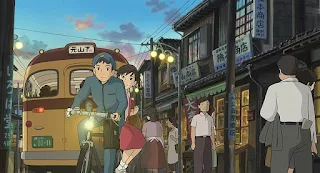From Up On Poppy Hills
In fact, there was almost too much information! There are also many live action films and so on from the period which were a great help and I interviewed women who were high school students at the time. However, this period was before Japan’s rapid economic growth and because people’s lifestyles were not as homogenized as they are now, I worried over how much of the characters’ lifestyles I should portray. It is true that I wasn’t born until 1967 but I don’t think much had changed since ’63 so I feel that memories from my childhood also helped me.
This film is set just before the Tokyo Olympics in 1964, which is generally seen as a symbol for the birth of modern Japan. From Up On Poppy Hill has that conflict between the past and the future as a central theme. Could you explain that to a non-Japanese audience?
I think this period was in the gap between the confusion of the war and settling down in its aftermath and the mania of rapid economic growth.
Symbolically, you could say it was the very short ‘calm period’ on the boundary line between the ‘blood-stained period’ and the ‘moneyed period’.
Nostalgia is a key theme in From Up On Poppy Hill and other Ghibli films. What is so attractive about nostalgia, and nostalgic representations of the past?
I think the present is always vivid. But you could also say that it gets old quickly. It would be different if I was trying to give a vivid portrayal of present-day issues but that is not what I want to do. I would go as far as to say that it may be possible to portray modern themes in a refined form by making a point of using the past as a platform. And I believe that the past is etched into our memories in one form or another even if we don’t have any direct knowledge of the actual period.
I think that this is why Studio Ghibli films are tinged with nostalgia for everyone. Even teenage girls who watched From Up On Poppy Hill said it was nostalgic.
How different is it working on a real-world, period drama like From Up On Poppy Hill after working on a grand fantasy epic like Tales From Earthsea?
If the story is based in a fantasy world, there is a fair amount of freedom in lifestyle, landscape and people’s behaviour. However, when the story is based in the real world, you can’t avoid some semblance of reality. Finding the balance between how much the story is based on truth and how far you can go in making things up is much more difficult [in From Up On Poppy Hill] than Tales From Earthsea.
What do you think is the goal of good animation?
I think that animation portrays living people and the living world in a more refined manner than live action films and that is what we should strive for.
Before you made Tales From Earthsea, you worked in landscaping and the design of parks and gardens. Did that awareness of the aesthetics of space help you once you moved into animation?
I think it helped me more in understanding space rather than in spatial aesthetics. However, animation is pictures and I think that discernment and skill are essential in order to draw beautiful pictures. In that sense, I am always soul-searching about being too particular about reality and not coming up to scratch with the drama.
The pure motivation for my work at the Ghibli Museum was to create a place full of excitement that would please visitors in a different way than the films.
As a result, I think that my desire to become involved in the animation process was sparked by having the opportunity to come into close contact with actual animation production.
What anime films or TV series inspired you when you were younger? Are you still inspired by new anime films now? If so, which?
I think I was influenced in the same way by the same things that other kids of my generation watched. Heidi, Girl Of The Alps and 3000 Leagues In Search Of Mother [both directed by Ghibli co-founder Isao Takahata] are a given but also Ultraman, Space Battleship Yamato and Gundam are included.
However, my strongest memories even now are of films made by Isao Takahata and Hayao Miyazaki. More recently, I was strongly affected by Hayao Miyazaki’s The Wind Rises. It is my current object of admiration.
One debate that is always raging among English-speaking Ghibli fans is whether they should watch the films with English subtitles, or in the English language versions. Do you think one is better than the other?
I think that subtitles are good because the viewer can experience the atmosphere and nuances that the voice actors’ performances bring to the film.
However, I think that a well-dubbed version is on a par with subtitles. In actual fact, I am very pleased with the US dubbed version of From Up On Poppy Hill and I have the utmost respect for the people involved in the dubbing.










Comments